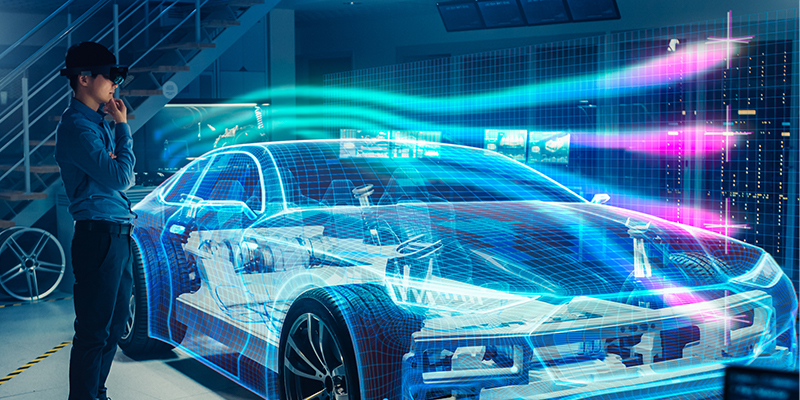AR Makes Air Visible: Aerodynamic simulations of vehicles are an exciting AR use case. Air motions or other physical processes, which are invisible to the naked eye can be shown via smart glasses in a real environment. Consequently, industrial engineers can better analyze variables such as velocity as well as pressure contour of the 3D surfaces of a car. Prerequisite for these data-intense and interactive air flow simulations is a powerful duo: AR Flow, the app for numerical simulations and ISAR SDK, the performance boost for AR and VR devices.
Aerodynamics measure variables like air flow and air resistance of objects. To optimize these variables, experts aim to identify those parts, where performances are compromised and consider measures to solve these problem areas. For example, more air resistance at a certain surface of the vehicle means higher fuel consumption and a deceleration at high speeds (amongst other variables of course).
Aerodynamic simulations are typically very complex technical data sets, which are never easy to be fully understood or conveyed by any kind of audience: technical or non-technical. Currently results are analyzed either in 2D in the form of pictures, presentations or videos or as a 3D file (CAD, CFD/FEA data) that requires specific software. Since results and data are still projected on flat 2D screens, a lot of information is easily overseen.
More Creativity in Data Analysis with Augmented Reality
AR/VR/MR technologies provide a more engaging and interactive playground for simulations. The user is part of the results that are shared. He is able to move around and select or switch data on and off. He can freely and impulsively adjust his own perspective; and focus only on those parts he finds relevant and interesting. AR Flow is a tool to visualize data obtained from numerical analysis in augmented reality.
Marco Losurdo, Senior R&D Engineer of AR Flow states:
“So far, we realized great results with the visualization of turbulence, heat release and species concentration. Currently we are working on the 3D rendering of turbulence, fine particles and multiphase flows. I’m convinced that this new way of working with data, enhances the comprehension of any scientific result.”
Compared to immersive VR, AR does not isolate the user from his surroundings. It’s even possible to track a real-world object such as a car and compute and visualize velocity and pressure contour over the car’s body surfaces.
Empowered by XR Streaming
Although AR simulation apps provide enormous potential, they are rarely used in industries. One major reason for this lies in their technical feasibility: Numerical computing is based on arbitrary meshes and has a very high computational cost in terms of rendering. These capacities cannot be met by mobile XR devices.
“If an app is directly installed on a smart device, a maximum size limit around 2Gb or even less is given. I couldn’t have met this requirement with the AR Flow app by far. Therefore, the ISAR SDK was an important piece of the puzzle”, Marco Losurdo reports.
ISAR SDK is an XR streaming solution that outsources the rendering process away from the XR device to a local server or the cloud. It can be integrated as a plugin within less than 20 minutes. And as an outcome the entire XR app with all its functionalities gets streamed.
Conclusion
Augmented reality has proven to bring substantial value to the visualization and comprehension of complicated technical information. However, when it comes to very complex data sets such as simulations, the limited computing and graphical power of mobile XR devices set limits to interesting use cases. XR Streaming removes these bottlenecks and lets immersive technologies unfold in all their complexity.



